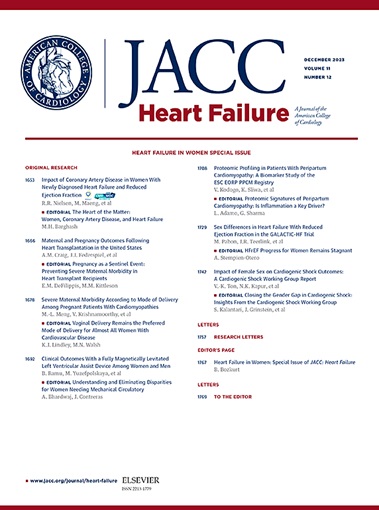Semaglutide and Exercise Function in Obesity-Related HFpEF
IF 11.8
1区 医学
Q1 CARDIAC & CARDIOVASCULAR SYSTEMS
引用次数: 0
Abstract
Background
Exercise function quantified by 6-minute walk distance (6MWD) is severely impaired in patients with heart failure with preserved ejection fraction (HFpEF).
Objectives
This prespecified secondary analysis of pooled data from the STEP-HFpEF Program (Research Study to Investigate How Well Semaglutide Works in People Living With Heart Failure and Obesity) examined factors associated with impaired exercise function at baseline, detailed effects of semaglutide on 6MWD, and on other key trial endpoints according to baseline 6MWD in patients with HFpEF.
Methods
Associates of 6MWD were assessed at baseline, and effects of semaglutide on 6MWD were evaluated at early (20 weeks) and final (52 weeks) time points, across subgroups, and according to the magnitude of weight loss achieved. Effects of semaglutide on the dual primary (changes in Kansas City Cardiomyopathy Questionnaire–Clinical Summary Score [KCCQ-CSS] and body weight) and secondary/exploratory endpoints were contrasted by tertiles of baseline 6MWD.
Results
The authors randomized 1,145 patients to semaglutide or placebo. Compared with patients who had obesity-related HFpEF and higher 6MWD, those with lower 6MWD were older and had lower KCCQ-CSS, higher body mass index and waist circumference, greater systemic inflammation (higher C-reactive protein), and more severe congestion (higher N-terminal pro–B-type natriuretic peptide, more diuretic use). Treatment with semaglutide increased 6MWD compared with placebo, an effect apparent at 20 weeks (treatment difference 14.6 m [95% CI: 8.6-20.7 m; P < 0.0001]) that was maintained at 52 weeks (treatment difference 17.1 m [95% CI: 9.2-25.0 m; P < 0.0001]). Increases in 6MWD with semaglutide (vs placebo) were similar across all relevant subgroups, with no significant interactions. Treatment with semaglutide increased KCCQ-CSS and reduced body weight, reduced C-reactive protein, improved the hierarchical composite (death, heart failure events, change in KCCQ-CSS and 6MWD), and reduced N-terminal pro–B-type natriuretic peptide across the spectrum of baseline 6MWD (all Pinteraction = NS). Each 1-unit decrease in body mass index on treatment with semaglutide was associated with a 4.1 m (95% CI: 2.4-5.7 m) increase in 6MWD (P < 0.0001).
Conclusions
In patients with obesity-related HFpEF, impaired 6MWD is most strongly associated with excess adiposity, congestion, and inflammation. Semaglutide-mediated improvements in HF-related symptoms, physical limitations, and exercise function were consistent across the spectrum of baseline 6MWD, observed as early as 20 weeks after the initiation of treatment, preceding maximal weight loss. The effects were consistent across subgroups. There was strong correlation between greater magnitude of weight loss and greater improvements in 6MWD. (Research Study to Investigate How Well Semaglutide Works in People Living With Heart Failure and Obesity [STEP-HFpEF], NCT04788511; Research Study to Look at How Well Semaglutide Works in People Living With Heart Failure, Obesity and Type 2 Diabetes [STEP-HFpEF DM], NCT04916470)
在肥胖相关的HFpEF中,西马鲁肽和运动功能
以6分钟步行距离(6MWD)量化的运动功能在保留射血分数(HFpEF)的心力衰竭患者中严重受损。这项预先指定的对STEP-HFpEF项目(研究Semaglutide对心力衰竭和肥胖患者的疗效的研究)汇总数据的二次分析,检查了与基线运动功能受损相关的因素,Semaglutide对6MWD的详细影响,以及根据HFpEF患者基线6MWD的其他关键试验终点。方法在基线时评估6MWD相关因素,并在早期(20周)和最终(52周)时间点、跨亚组和根据体重减轻的程度评估西马鲁肽对6MWD的影响。西马鲁肽对双重主要终点(堪萨斯城心肌病问卷-临床总结评分[KCCQ-CSS]和体重的变化)和次要/探索终点的影响通过基线6MWD的分位数进行对比。结果:作者将1145名患者随机分为西马鲁肽组和安慰剂组。与肥胖相关HFpEF和高6MWD患者相比,低6MWD患者年龄更大,KCCQ-CSS更低,体重指数和腰围更高,全身性炎症更严重(c反应蛋白更高),充血更严重(n端前b型利钠肽更高,利尿剂使用更多)。与安慰剂相比,西马鲁肽治疗增加了6MWD,在20周时效果明显(治疗差值14.6 m [95% CI: 8.6-20.7 m; P < 0.0001]),并维持在52周(治疗差值17.1 m [95% CI: 9.2-25.0 m; P < 0.0001])。在所有相关亚组中,西马鲁肽(与安慰剂)的6MWD增加相似,没有显著的相互作用。西马鲁肽治疗增加KCCQ-CSS,降低体重,降低c反应蛋白,改善分层复合(死亡,心力衰竭事件,KCCQ-CSS和6MWD的变化),减少基线6MWD谱上n端前b型利钠肽(所有p相互作用= NS)。使用西马鲁肽治疗时,体重指数每降低1个单位,6MWD增加4.1 m (95% CI: 2.4-5.7 m) (P < 0.0001)。结论在肥胖相关HFpEF患者中,6MWD受损与过度肥胖、充血和炎症密切相关。早在开始治疗后20周,在最大体重减轻之前,在基线6MWD范围内,semaglu肽介导的hf相关症状、身体限制和运动功能的改善是一致的。这些效果在各个亚组中是一致的。体重减轻的幅度越大,6MWD的改善越大,两者之间存在很强的相关性。研究Semaglutide对心力衰竭和肥胖患者疗效的研究[STEP-HFpEF];研究Semaglutide对心力衰竭、肥胖和2型糖尿病患者疗效的研究[STEP-HFpEF DM], NCT04916470)
本文章由计算机程序翻译,如有差异,请以英文原文为准。
求助全文
约1分钟内获得全文
求助全文
来源期刊

JACC. Heart failure
CARDIAC & CARDIOVASCULAR SYSTEMS-
CiteScore
21.20
自引率
2.30%
发文量
164
期刊介绍:
JACC: Heart Failure publishes crucial findings on the pathophysiology, diagnosis, treatment, and care of heart failure patients. The goal is to enhance understanding through timely scientific communication on disease, clinical trials, outcomes, and therapeutic advances. The Journal fosters interdisciplinary connections with neuroscience, pulmonary medicine, nephrology, electrophysiology, and surgery related to heart failure. It also covers articles on pharmacogenetics, biomarkers, and metabolomics.
 求助内容:
求助内容: 应助结果提醒方式:
应助结果提醒方式:


